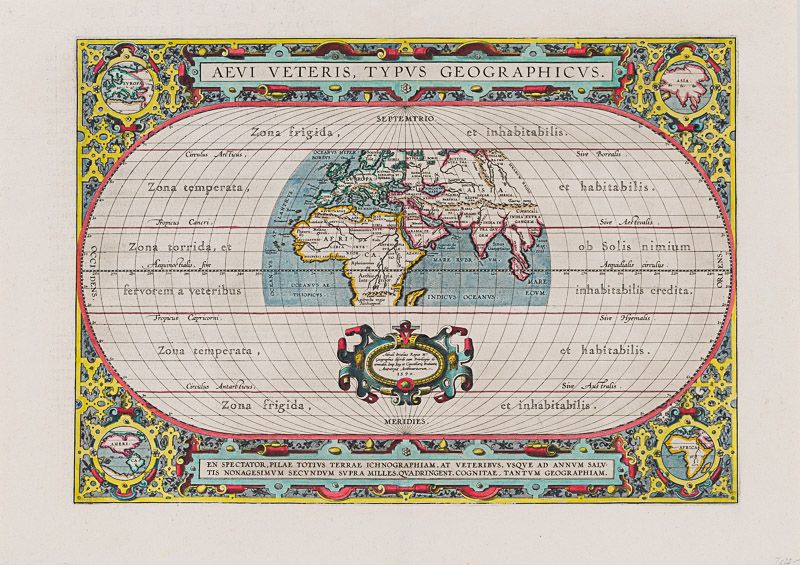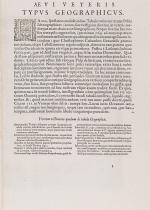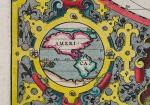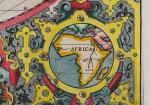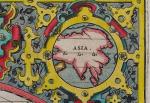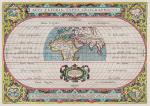Ortelius, Aevi veteris, Typus Geographicus.
Aevi veteris, Typus Geographicus.
Original hand-coloured engraving. Antwerp, Ortelius, 1590. Plate Size: 44 cm x 31 cm. Sheet Size: 53.7 cm x 38.5 cm. Original map. Very good, actually stunning, condition. Really clean and crisp. Generous margins. Reverse recto carries Latin text.
[Shirley 176; Broecke 186.1; Koeman III, 0800H:31].
Beautifully unusual and richly decorated map of the Ancient World based upon the work of Claudius Ptolemy, from Ortelius’ Parergon (‘Supplement’). The depicted land masses of Europe, Africa and western Asia are largely in their modern configurations, although the place names on the map are based upon Ptolemy. The southern portion of Africa is missing and China is not included on the map.
A small number of cities, including Hispalis (Seville), Lutetia (Paris), Rome, Byzantium (Istanbul), Hierusalem (Jerusalem), Alexandria, and Memphis are identified.
Relief shown pictorially. The mythical Luna Montes (Mountains of the Moon) – the fabled source of the Nile – can be seen in the southern half of Africa. Madagascar is also included. The climate zones are shown as ‘Zona frigida et inhabitablis’, ‘Zona temperata et habitabilis’, and ‘Zona torrida, et ob Solis nimium fervorem a veteribus inhabitabilis credita.’ The tropics and Arctic and Antarctic circles are also shown. The ‘Zona frigida’ lying above the Arctic Circle and the region lying at the Equator are described as being inhospitable.
The border of the globe carries longitudinal and latitudinal information. The outer areas of the map are decoratively patterned and there is one inset roundel map in each corner, showing the different continents depicting (in clockwise order) Europe, Asia, Africa and the Americas.
Ortelius’ characteristic strapwork design ornaments the title cartouche above the globe as it does the cartouche seen beneath it. It bears the inscription: “En Spectator Pilae Totius Terrae Ichnographiam, at Veteribus Usque ad Annum Salutis Nonagesimum Secundum Supra Milles Quadrigent. Cognitae, Tantum Geographiam.” Immediately underneath the illustrated landmass is a further cartouche, similarly ornamented, decorated with two lion heads and bearing an oval inset statement of responsibility in Latin script.
The Parergon was, conceived initially as a supplement to Ortelius’ Theatrum Orbis Terrarum (Theatre of the World). The work, a vast and finely researched index of the Classical world, was accompanied by a number of ancient world maps. Unlike the maps of the Theatrum, the majority of which were reductions of earlier maps, the maps of the Parergon were researched and drawn by Ortelius himself. The work was a great commercial success, and the maps themselves set the standard for ancient world maps for the duration of the 17th Century.
Abraham Ortelius was a Flemish cartographer and geographer, conventionally recognized as the creator of the first modern atlas, the Theatrum Orbis Terrarum (Theatre of the World). He was one of the most notable figures of the Dutch school of cartography during its golden age (approximately 1570s-1670s).
- Keywords: 16th Century · Ancient World · Cartography · Catalogue No.5 – Maps of the World · Earth · Globe · Map · Original Engraving · Original Map · Original Maps · Ortelius · Ptolemy · Rare Map – The World · Rare Map Africa · Rare Map Asia · Rare Map Europe · Vintage Map
- Inventory Number: 200018AG
EUR 810,--
© 2025 Inanna Rare Books Ltd. | Powered by HESCOM-Software




